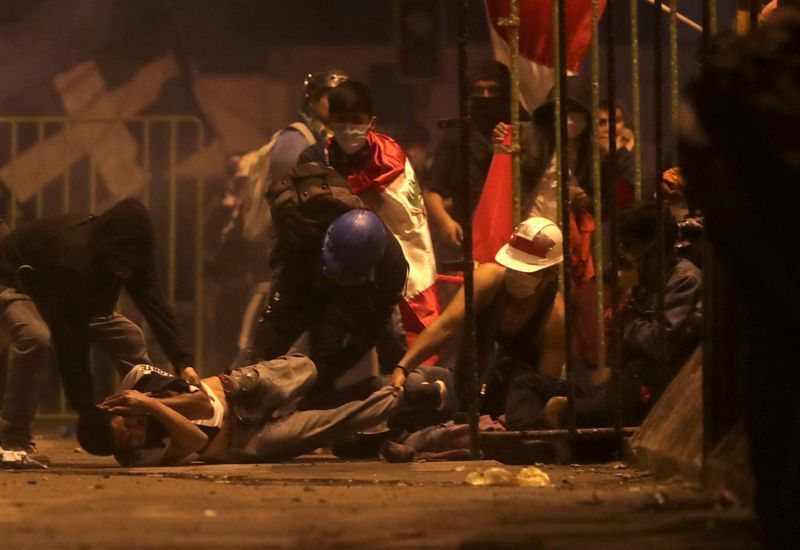RIO DE JANEIRO, BRAZIL – (Reuters) Ruben Guevara was marching in teargas-filled streets in Lima in November when he was hit in the face by what felt like a gas canister, severely damaging his right retina.
“We were protecting people who had already fallen to the ground and police kept moving forward and shooting straight at us,” said Guevara, 32, a father of two.
Guevara was one of millions of Peruvians who marched against interim President Manuel Merino last month. After just five days in power, and faced by intense protests in Lima that led to the deaths of two demonstrators and some 200 injuries, Merino resigned.

The reaction by police to the protests in the capital has ignited a debate about police brutality, which human rights advocates say has historically been more common in the country’s interior, where low-income Peruvians have a harder time demanding accountability.
At least 20 demonstrators were shot with lead pellets or glass marbles during the Lima protests, according to medical records, interviews and information compiled by the local Human Rights Coordinator. On Thursday, Human Rights Watch said there was “credible and solid” evidence that such ammunition had been used by the police.
At least half a dozen of those injured were hospitalized for over three weeks. A third person died in protests in northern Peru earlier this month.
Peru’s police declined to comment for this report. They have previously said they only used rubber bullets in counteracting protesters, and that any pellets or marbles must have been shot by the protesters instead.
Jorge Vasquez, a pathologist in Lima who examined the body of one of those killed in the protests, as well as victims of a deadly nightclub stampede in August that was sparked by a police raid, said the number of deaths he was seeing as a result of police actions had increased this year.
Police in Lima had caused “deaths that didn’t need to happen,” he said, adding that in his opinion police were “getting out of control.”
In the wake of U.S. demonstrations against racial injustice and police brutality this year, Latin America has also seen a wave of anger over perceived police impunity, with protests in Chile, Colombia, Mexico and Brazil.
In Peru, human rights advocates say police forces have been emboldened in part by a new ‘Police Protection Law’ passed in the early days of the coronavirus pandemic that backs officers who shoot on duty.
Peru’s new interim president Francisco Sagasti, a centrist who replaced Merino, has vowed there will be “no impunity” for violent officers, and removed 18 senior police chiefs from duty in the wake of the protests, citing the need to “strengthen” the police.
No police officer has been charged or named as a potential suspect for actions relating to the protests.
Reuters TV footage filmed at the height of the protests in Lima showed how police fired tear gas without verbal warnings, aiming canisters either at body-height or at the sky, raising risk of injury.
It showed police opening fire on demonstrators who had previously thrown rocks and other implements. None of the demonstrators appeared to be armed with firearms.
Protester Jack Pintado died in Lima on November 14th, with 10 lead pellets lodged in his upper body, legal records show. Three weeks later, Jorge Munoz died on a sidewalk in Peru’s north after being hit by a “lead projectile.”
“Police killed him!,” bystanders shouted as they desperately poured water on Munoz’s injured skull, videos show. A row of riot police stood meters away.
Others survived, their bodies heavily maimed. Lucio Suarez was hit in the head by three lead pellets which penetrated his skull and lodged in his brain, medical records show. Andres Rivero was also hit in the head, fracturing his skull. He was hospitalized for weeks and needs another surgery in January.
“Police reform?,” asked his father Mario Rivero, outside the hospital where Andres spent more than three weeks. “Sure, but first I want to see the officer who did this to my son punished.”
In an interview with Reuters, Jose Luis Perez Guadalupe, who served as interior minister between 2015 and 2016, said he believed it was “highly likely” that the pellets that caused the injuries were shot by police.
Others protesters, like Guevara, suffered injuries from teargassing. Reuters footage shows that at one point police shot a dozen canisters in the span of 10 seconds, forcing protesters to turn political cardboard signs into makeshift shields.
“A lot of unprotected people coupled with police who appear to not be particularly good at this: it’s kind of a recipe for disaster,” said Ed Maguire, a criminology professor at Arizona State University.
Several protesters recounted how police threw gas canisters at panicked crowds. “When we tried to get through the gas, the police shot at us again,” said Cesar Lecarnaque, a medical student who said he tended to three pellet victims on November 14th. “I thought I was going to die.”
Alonso Chero, a photographer for daily El Comercio, was covering the protests in Lima when officers began firing, he said. As he crouched and ran toward the protesters for safety he felt the impact of a shot in his back. A doctor later filmed how he extracted a glass marble from Chero’s body that barely missed his spine.
“To me the decision to use a glass marble is no different than the decision to fire a regular gun,” said Maguire.

